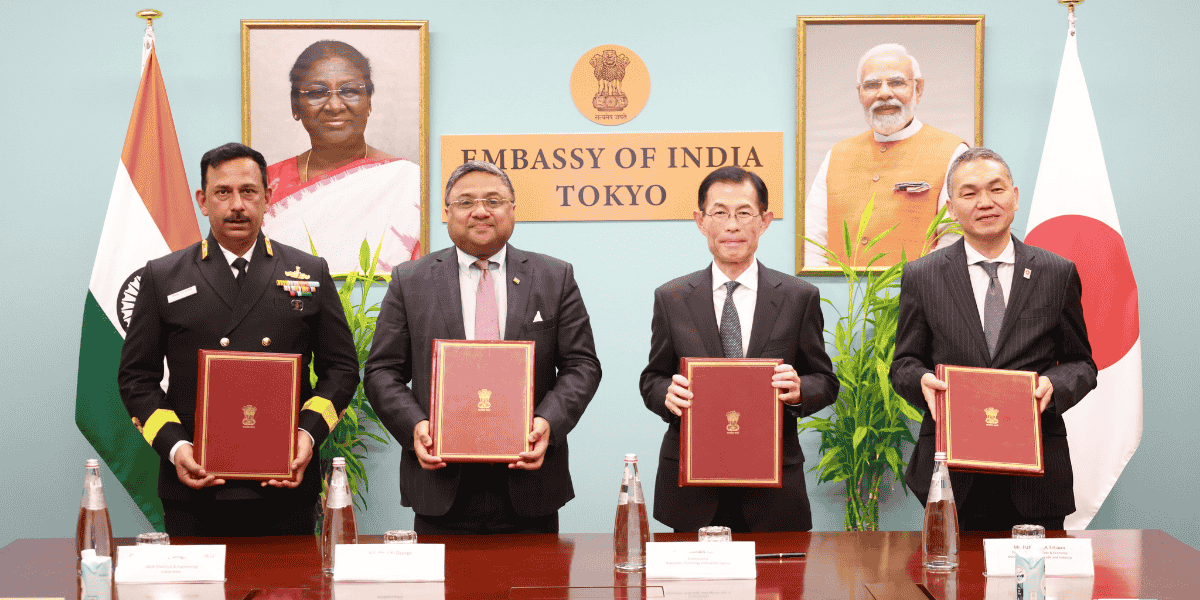The long-drawn negotiations between India and Japan culminated in the two countries’ agreement to co-develop the UNICORN (Unified Complex Radio Antenna) Nora-50 integrated mast for the Indian Navy’s warships.
India has been finding it difficult to access the technology. The Japanese UNICORN Nora-50 integrates multiple communication antennas into a single piece (mast).
India still faces difficulties making weapon-grade antennas, especially radars. It still relies on imported sets for its communication network. Encryption in the military-grade communication set is another issue.
The Memorandum of Intent for the antenna that will be put on board future Indian destroyers was inked in Tokyo. The event was attended by the Indian Ambassador to Japan, Sibi George, and Japan’s DG of the Ministry of Economy, Trade and Industries, Fukunaga Tetsuro. The officials of the Indian Navy and Bharat Electronics Limited (BEL) were also present at the signing event.
The Indian public sector undertaking BEL is likely to be the co-developer of this sophisticated technology. The co-development will take place under the India-Japan Defense Technology Cooperation.
At present, the Indian Navy uses the BEL-supplied Advanced Composite Communication System (ACCS), a fourth-generation voice and data integrated system for the ship’s external communication.

The units include the 1kW Transmitter Aerial Switching Rack (ASR) to switch four High-Frequency (HF) Transmitters to four HF Antennas. This assists the user in switching any radio to any of the antennas for redundancy, and the user can also remotely control the same utilizing an IP-based Network.
In other words, the Indian philosophy is to follow space-frequency diversity.
Unicorn systems are in service onboard Japan Maritime Self-Defense Force’s Mogami-class destroyers. The system’s horn-shaped structure has numerous antennas for tactical data links. TACAN (Tactical Air Navigation System) and communications are integrated within the mast’s design, reducing signature and ship-building time and saving below-deck space. It will also improve the stealth characteristics of Naval Platforms.
“Unicorn’s pathbreaking design brings improvements by way of reduction of the antennas’ mutual interference, reducing the ship’s overall Radar Cross Section (RCS), enhancing maintainability and lightning resistance,” Commander Milind Kulshrestha (retired) from the Indian Navy explained.
“This innovative Japanese design has evolved from their TACAN antenna design framework. In a TACAN system, the Naval platform constitutes a mobile transmitting unit. The airborne unit, in conjunction with the Naval platform, processes the transmitted signals to a visual presentation of both azimuth and distance information,” he adds.
The UNICORN system can detect the movement of missiles and drones from afar by sensing radio waves over a wide area.
The NORA-50 antenna was jointly developed by Japanese companies, including electronics maker NEC and Yokohama Rubber. A report in the Nikkei Asia said that the Japanese government is still deciding how many antennas will be sold and is working out the contract cost. The deal is seen from the prism of strengthening deterrence of like-minded countries in the Indo-Pacific region.
The Japanese law forbids the export of defense equipment that could be used as a lethal weapon. The UNICORN would not violate the law as it is a communication tool. The deal with India is the second instance of Japan exporting defense equipment since it revoked the ban on military sales in 2014. The first military export happened in 2023 when radar systems were exported to the Philippines.
Japan-India has signed an agreement on defense equipment and technology transfer in 2015.
Recently, India has placed great emphasis on technology transfer to boost the manufacturing of defense equipment in India. The agreement with Japan will pave the way for future collaboration between the two countries on new and critical technologies, including semiconductors, artificial intelligence, renewables, electric mobility, and more.
India approved its first semiconductor fabrication plant and two assembly units in March 2024. They will be developed jointly by local conglomerates and companies from Japan, Taiwan, and Thailand.
Enemy’s Enemy Is A Friend
Japan, India, the US, and Australia are members of the QUAD. In recent times, their security interests have converged in the face of China’s increasingly assertive economic and military activities in the Indo-Pacific. The two countries have drawn closer under a shared vision of realizing “a free and open Indo-Pacific.”
Japan has seen Chinese coast guard vessels repeatedly enter its waters around the Tokyo-controlled, Beijing-claimed Senkaku Islands in the East China Sea. At the same time, India has a long-running territorial dispute with China in the Himalayan border areas.
The year 2024 saw the first air visit by Japanese fighters to India and their participation at Tarang Shakti, the first multilateral exercise hosted by the Indian Air Force. The countries also conducted the maiden edition of the bilateral fighter exercise ‘Veer Guardian 2023’ between the Japan Air Self Defence Force (JASDF) and the Indian Air Force (IAF).
Japan is also helping India develop the Andaman and Nicobar Island chain, strategically located near the mouth of Southeast Asia’s main shipping lane. This is part of New Delhi’s broader plan to monitor China’s naval assets, especially its submarines.
Japan has given India 4.02 billion yen ($31 million) in aid to develop the islands. This was the first time that India accepted foreign assistance for development on the islands.
The islets are the only area in India with naval, air, and ground forces intended to deter China. If an armed conflict breaks out in the South China Sea, and if the US and, by default, Japan get involved, the Andaman and Nicobar could potentially play a crucial role.
There have been reports that India will be installing the Japan-US “fishhook” SOSUS (Sound Surveillance System, a chain of sensors designed to track submarines), creating a counter-wall against Chinese submarines loitering in the Andaman Sea and deep South China Sea.
It will be a crucial collaboration, as it is said that once up and running, Japan will share intelligence with the United Kingdom, Australia, and India.




